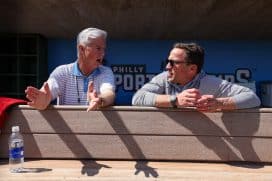By Matt Albertson, Historical Columnist
World War II put Major League Baseball in a serious bind for talent. Athletes were made available for service, despite the fact that President Franklin Roosevelt deemed baseball essential. Unlike 1917, when baseball shortened its season when the United States entered the fray, Major League Baseball ran full length schedules throughout World War II. With prime players like Ted Williams and Bob Feller ditching baseball uniforms for military uniforms, the majors were depleted of talent that kept fans coming to the games. As a result, players who wouldn't have been considered for the majors suddenly found themselves on the highest stage in baseball, like one-armed Pete Gray in St. Louis and aged veterans like Jimmie Foxx, who signed with the beleaguered Phillies in February 1945 after being released by the Cubs the previous year.
Foxx was a Goliath in the late 1920s and early 1930s when he led the other Philadelphia club – Connie Mack's Athletics – to three straight pennants and two World Series titles in 1929 and 1930. Some baseball historians argue that the 1929 Athletics were the greatest team in baseball history, even better than the lauded 1927 "Murders Row" Yankees.
Foxx was a Maryland native who built an incredible physique on the family farm. Connie Mack historian Norman Macht wrote "[Foxx] played infield and outfield, pitched, and caught for his high school and town teams, had bulging forearms and biceps built by lifting milk cans and heaving hay bales…and a cannon for an arm." This powerful build allowed Foxx to launch baseballs out of any ballpark in America and was the reason he was nicknamed "The Beast." Foxx challenged Babe Ruth's unbreakable single season home run record when he hit 58 home runs for the A's in 1932.
He was among those selected to represent the American League in the inaugural All-Star game in 1933 and made nine straight All-Star appearances between 1933 and 1941. Additionally, he was selected as the league MVP in 1932, 1933, and 1938.
Like his first dynasty in the 1900's and 1910's, Connie Mack sold off his championship squad to stay afloat and traded Foxx and Johnny Marcum to the Boston Red Sox for George Savino, a minor leaguer, Gordon Rhodes and $150,000. His 1938 season quelled suspicions that his career was on the decline when he hit 50 home runs, drove in 175 RBI (still a Red Sox record) and led the league with a slash line of .349/.462/.704. In 1939, Ted Williams made his major league debut. The passionate hitter boasted to teammates "Wait until Foxx sees me hit!" The combo kept the Red Sox in contention for the American League pennant that year but came up short. He retired from the game after the 1942 season. He volunteered for military service in 1944 but was rejected due to sinus issues and returned to the Cubs as a player-coach.
Foxx signed with the Phillies as his career came full-circle geographically to Philadelphia where he first played for the Athletics as a 17-year-old youngster. He was a shell of his former self, playing in 89 games and slashing .268/.336/.420 with seven home runs and 38 RBI. He played 40 games at first base, 14 at third base, and even nine games as a pitcher. As a hurler with the Phils, Foxx started two games and finished the year with a 1-0 record and a 1.59 ERA in 22.2 innings pitched, highlighted by 10 strikeouts. On August 19, he pitched five no-hit innings in an emergency start.
He finally retired from playing for good after the 1945 season but stayed close to the game as coach and manager, most famously as the skipper of the 1952 Fort Wayne Daisies of the All-American Girls Professional Baseball League. Tom Hanks' character Jimmy Dugan in the 1992 film A League of their Own was loosely based on Foxx.
Career Accomplishments
- 1951 Hall of Fame inductee
- 1933 AL Triple Crown
- Nine-time All-Star
- Three time American League MVP
- Two-time World Series champion
*Awards were not factored into the formula
Career-Defining Moment
Foxx's 1932 campaign was historic. His 58 home runs and 169 RBI led the league and he slashed .364/.469/.479 which helped him achieve a 10.5 WAR campaign. Despite winning the 1933 American League Triple Crown (the Phillies' Chuck Klein won the 1933 National League Triple Crown in the same season, the only time both Triple Crown winners played in the same city) with 48 home runs, 163 RBI and a .356/.449/.749 slash line, the 1932 season was still more impressive.
His World Series statistics are equally impressive. In the 1929, 1930, and 1931 fall classics, he slashed .344/.425/.609 with four home runs and 11 RBI.
Reasoning for ranking
Foxx scored 83 points in our formula. He totaled 62.5 WAR, averaging 3.125 WAR over his 20 seasons. He had 14 seasons of 2+ WAR, 10 seasons at 5+ WAR and four season at 8+ WAR, totaling 50 points. His .325 average ranks 39th all-time, his 1.038 OPS ranks fifth all-time, his 2,646 hits ranks 78th all-time, his 458 doubles ranks 99th all-time, his 125 triples ranks 90th all-time, his 534 home runs ranks 19th all-time and his 1,922 RBI ranks ninth all-time, totaling 33 points
Foxx scored a one on our subjective importance scale because he joined the Phillies at the tail end of their dark years. The club had no identity in 1945 on the roster or in name, when the organization for two years attempted to change the club's official name to "Blue Jays". It's hard to believe that five years after Foxx retired, the Phillies won the National League pennant as one of the youngest and most exciting teams in the city's terrific baseball history.
Foxx barely made our cut for this list, which was limited from 1945-present. Despite his one year with the Phillies being mediocre in a backup role, he put together one of the greatest careers of any player in Major League history.
Explanation of scientific formula
The player rankings formula combines both traditional and advanced statistics/metrics and assigns a point total to each category.
Previous Players
- No. 25 – Ryan Howard
- No. 24 – Roy Oswalt
- No. 23 – Kenny Lofton
- No. 22 – Jimmy Rollins
- No. 21 – Cole Hamels
- No. 20 - Cliff Lee
- No. 19 – Tony Perez
- No. 18 – Bobby Abreu
- No. 17 – Scott Rolen
- No. 16 – Richie Ashburn
- No. 15 – Chase Utley
- No. 14 – Ryne Sandberg
- No. 13 – Dick Allen
- No. 12 – Jim Bunning
- No. 11 – Fergie Jenkins
- No. 10 – Jim Thome
- No. 9 – Curt Schilling
- No. 8 – Roy Halladay
- No. 7 – Robin Roberts
- No. 6 – Joe Morgan
- No. 5 – Pedro Martinez
- No. 4 – Pete Rose
- No. 3 – Steve Carlton







